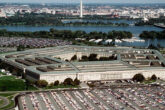August 07, 2014
With Shrinking Budgets, Pentagon Should Rely More on Guard, Reserve Troops
The release of the 2014 National Defense Panel reportlanded with a quiet thud last week as most of Washington headed out for August vacations. Much delayed from its original congressionally mandated release three months after theQuadrennial Defense Review, the NDP review seemingly ignored today’s intractable budgetary realties by arguing for an even bigger defense budget. At the same time, it offered few tradeoffs and even fewer creative ideas for building a more effective and efficient military.
Among many opportunities missed in this consensus report was the chance to call for a new appraisal of the fractious compact among the nation’s active, Guard and reserve forces. In an era of ever-tightening budgets, the United States must think more creatively about both how to structure and when to use reserve component capabilities. As multiple reports have noted, these part-time forces are less expensive, while they retain critical equipment and skilled uniformed personnel that might otherwise be slashed from the force entirely as budgets plummet. The NDPdoes not mention the reserve component at all in its 17-page Executive Summary, and only sporadically throughout the remaining 64 pages of the text – and then largely to buttress current roles and missions.
A better recommendation from the NDP would call for a full re-examination of how the nation can derive more capability from the large investment already committed to the Guard and reserves. Over the last 13 years, Guard and reserve units and individuals played crucial roles across the battlefields in Iraq and Afghanistan — indeed, many even in the active component would argue those wars would have been unsustainable without the all-out commitment of the nation’s reserves, the largest such commitment since the Korean War.
More from CNAS
-
Defense / National Security Human Capital Program
Sharper: The BudgetThe defense budget and its $715 million price tag accounts for much of the U.S. government's discretionary spending every year, but where will (and should) this money go in th...
By Anna Pederson
-
Defense / National Security Human Capital Program
Three elements of Army’s iron triangle equally critical for United States, says defense analystBilly Fabian, adjunct senior fellow for the Defense Program at the Center for a New American Security and senior analyst at Govini discusses the Army's iron triangle on Govern...
By Billy Fabian
-
Defense / National Security Human Capital Program
The Fiscal Year 2022 Defense Budget and Future Options for the PentagonSubmitted Written Testimony I. Introduction Chairman Smith, Ranking Member Rodgers, distinguished members of the committee and staff thank you for inviting me to testify today...
By Stacie Pettyjohn
-
Defense / National Security Human Capital Program
Risky Business: Future Strategy and Force Options for the Defense DepartmentTo consider the next defense strategy and the tradeoffs associated with different options, we developed three possible strategies—high-end deterrence, day-to-day competition, ...
By Stacie Pettyjohn, Becca Wasser & Jennie Matuschak



